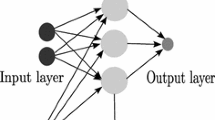Abstract
This contribution proposes a novel neural-network-based control approach to stabilize a nonlinear aeroelastic wing section. With the prerequisite that all the states of the system are available, the proposed controller requires no comprehensive information about structural nonlinearity of the wing section. Furthermore, the proposed control approach requires no human intervention of designing goal dynamics and formulating control input function, which is difficult to be realized by the typical neural-network-based control following an inverse control scheme. Simulation results show that the proposed controller can stabilize the aeroelastic system with different nonlinearities.
Similar content being viewed by others
References
Librescu L, Marzoeca P. Advances in the linear/nonlinear control of aeroelastic structural systems. ACTA Mech, 2005, 178: 147–186
Ko J, Strganac W T, Kurdila A J. Adaptive feedback linearization for the control of a typical wing section with structural nonlinearity. Nonlinear Dyn, 1999, 18: 289–301
Singh S N, Wang L. Output feedback form and adaptive control of a nonlinear aeroelastic system. J Guidance, Contl Dyn, 2002, 4: 725–732
Xing W, Singh S N. Adaptive output feedback control of a nonlinear aeroelastic structure. J Guidance Contl Dyn, 2000, 6: 1109–1116
Behal A, Marzocca P, Dawson D M, et al. Nonlinear adaptive model free control of an aeroelastic 2-D lifting surface. AIAA Guidance, Navigation, and Control Conference and Exhibition, AIAA-2004-5227, 2004
Zhang F, Soeffker D. Active flutter suppression of a nonlinear aeroelastic system using PI-Observer. In: Ulbrich H, Ginzinger L, eds. Motion and Vibration Control, Netherlands: Springer, 2009. 367–376
Haley P, Soloway D. Generalized predictive control for active flutter suppression. IEEE Contl Sys Mag, 1997, 17: 64–70
Ku C-S, Hajela P. Neural-network-based controller for nonlinear aeroelastic system. AIAA J, 1998, 36: 249–255
Bernelli-Zazzera F, Mantegazza P, Mazzoni G, et al. Adaptive flutter suppression using recurrent neural networks. J Guidance Contl Dyn, 2000, 23: 1030–1036
Gujjula S, Singh S N, Yim N. Adaptive and neural control of a wing section using leading- and trailing-edge surfaces. Aerosp Sci Technol, 2005, 9: 161–171
Ku C-S, Hajela P. Optimized neurocontroller for vibration reduction in helicopter blades. Eng Optim, 1999, 31: 541–569
Scott R C, Pado L E. Active control of wind-tunnel model aeroelastic response using neural networks. J Guidance Contl Dyn, 2000, 23: 1100–1108
Mattaboni M, Quaranta G, Mantegazza P. Active flutter suppression for a three-surface transport aircraft by recurrent neural networks. J Guidance Contl Dyn, 2009, 32: 1295–1307
Chow T W S, Fang Y. A recurrent neural-network-based real-time learning control strategy applying to nonlinear systems with unknown dynamics. IEEE Trans Indus Elec, 1998, 45: 151–161
Waszak M R. Robust multivariable flutter suppression for the benchmark active control technology (BACT) wind-tunnel model. J Guidance Contl Dyn, 1997, 1: 143–147
Scott R C, Hoadley S T, Wieseman C D, et al. Benchmark active controls technology model aerodynamic data. J Guidance Contl Dyn, 2003, 23: 914–921
Bennett R M, Scott R C, Wieseman, C D. Computational test cases for the benchmark active controls model. J Guidance Contl Dyn, 2000, 23: 922–929
Mukhopadhyay V. Transonic flutter suppression control law design and wind-tunnel test results. J Guidance Contl Dyn, 2000, 23: 930–937
Meiser S. Points location in arrangements of hyperplanes. Info Comp, 1993, 106: 286–303
Powell M J D. Radial Basis Function Approximation to Polynomials. In: Numerical Analysis 1987. White Plains, New York: Longman Publishing Group, 1989. 223–241
Fliess M, Join C, Sira-Ramirez H. Nonlinear estimation is easy. Int J Mod Ident Contl, 2008, 4: 12–27
Author information
Authors and Affiliations
Corresponding author
Rights and permissions
About this article
Cite this article
Zhang, F., Söffker, D. Quadratic stabilization of a nonlinear aeroelastic system using a novel Neural-Network-based controller. Sci. China Technol. Sci. 54, 1126–1133 (2011). https://doi.org/10.1007/s11431-011-4346-8
Received:
Accepted:
Published:
Issue Date:
DOI: https://doi.org/10.1007/s11431-011-4346-8




